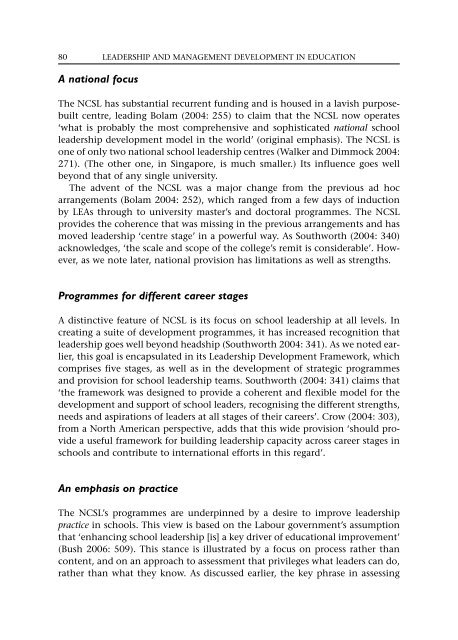Leadership and Management Development in Education (Education ...
Leadership and Management Development in Education (Education ...
Leadership and Management Development in Education (Education ...
Create successful ePaper yourself
Turn your PDF publications into a flip-book with our unique Google optimized e-Paper software.
80LEADERSHIP AND MANAGEMENT DEVELOPMENT IN EDUCATIONA national focusThe NCSL has substantial recurrent fund<strong>in</strong>g <strong>and</strong> is housed <strong>in</strong> a lavish purposebuiltcentre, lead<strong>in</strong>g Bolam (2004: 255) to claim that the NCSL now operates‘what is probably the most comprehensive <strong>and</strong> sophisticated national schoolleadership development model <strong>in</strong> the world’ (orig<strong>in</strong>al emphasis). The NCSL isone of only two national school leadership centres (Walker <strong>and</strong> Dimmock 2004:271). (The other one, <strong>in</strong> S<strong>in</strong>gapore, is much smaller.) Its <strong>in</strong>fluence goes wellbeyond that of any s<strong>in</strong>gle university.The advent of the NCSL was a major change from the previous ad hocarrangements (Bolam 2004: 252), which ranged from a few days of <strong>in</strong>ductionby LEAs through to university master’s <strong>and</strong> doctoral programmes. The NCSLprovides the coherence that was miss<strong>in</strong>g <strong>in</strong> the previous arrangements <strong>and</strong> hasmoved leadership ‘centre stage’ <strong>in</strong> a powerful way. As Southworth (2004: 340)acknowledges, ‘the scale <strong>and</strong> scope of the college’s remit is considerable’. However,as we note later, national provision has limitations as well as strengths.Programmes for different career stagesA dist<strong>in</strong>ctive feature of NCSL is its focus on school leadership at all levels. Increat<strong>in</strong>g a suite of development programmes, it has <strong>in</strong>creased recognition thatleadership goes well beyond headship (Southworth 2004: 341). As we noted earlier,this goal is encapsulated <strong>in</strong> its <strong>Leadership</strong> <strong>Development</strong> Framework, whichcomprises five stages, as well as <strong>in</strong> the development of strategic programmes<strong>and</strong> provision for school leadership teams. Southworth (2004: 341) claims that‘the framework was designed to provide a coherent <strong>and</strong> flexible model for thedevelopment <strong>and</strong> support of school leaders, recognis<strong>in</strong>g the different strengths,needs <strong>and</strong> aspirations of leaders at all stages of their careers’. Crow (2004: 303),from a North American perspective, adds that this wide provision ‘should providea useful framework for build<strong>in</strong>g leadership capacity across career stages <strong>in</strong>schools <strong>and</strong> contribute to <strong>in</strong>ternational efforts <strong>in</strong> this regard’.An emphasis on practiceThe NCSL’s programmes are underp<strong>in</strong>ned by a desire to improve leadershippractice <strong>in</strong> schools. This view is based on the Labour government’s assumptionthat ‘enhanc<strong>in</strong>g school leadership [is] a key driver of educational improvement’(Bush 2006: 509). This stance is illustrated by a focus on process rather thancontent, <strong>and</strong> on an approach to assessment that privileges what leaders can do,rather than what they know. As discussed earlier, the key phrase <strong>in</strong> assess<strong>in</strong>g
















